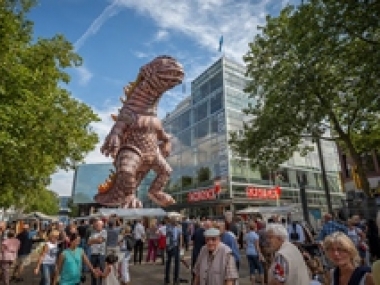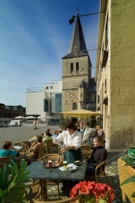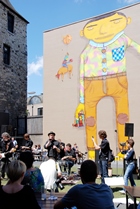City Centre Doctor stopped in Herleen: an inspiring meeting for all the participants
Edited on
03 March 2020After having hosted the First meeting of the second phase of the City Centre Doctor project, Richard van Beek (Herleen Project Manager) and Yvette Petit (Herleen ULG Coordinator) answer some questions and enlighten the positive effects of bottom-up approaches as well as of transnational cooperation.

Please, describe your city
Heerlen is a relatively young city. In the 19th century our region was dominated by agriculture. Our landscape was one of gently rolling hills, with fertile ground worked by farmers. Things changed dramatically around the turn of the century with the exploitation of new coal mines. Housing developments were built for miners and other mine workers, and the region experienced an exponential growth in population. Urbanization gathered apace, and these developments have led to our region being what it is today. Heerlen is part of an urban region of 250,000 inhabitants called “Parkstad”, of which Heerlen, with a population of 87,000, is the central municipality. It borders Germany, where the adjacent region of Aachen provides us with 259,000 neighbours.
For decades, the mines provided us with significant wealth. Heerlen was the most prosperous city in the Netherlands. But all this changed in 1965 with the decision to close the mines. This led to social and economic problems. Suddenly Heerlen joined the ranks of the least prosperous municipalities in the country. The city suffered severe decline. The challenge was, and remains to this day, to reinvigorate the position of Heerlen. Heerlen has been forced to rediscover itself. We believe in joining forces and working together. We therefore work with other municipalities from the region. In fact, there are eight municipalities within the ‘Parkstad’ region, all working together towards a brighter future. As an example of the truth of this, in March of this year the region was awarded the best tourist destination at the 2016 Tourism for Tomorrow Awards, by virtue of having developed the region from a problem region to a successful tourist area.
 We also need to make our city more attractive. For that reason we are working on improving the city centre. For example Maankwartier, a new part of Heerlen under construction with a train station, shops, hotel, offices and bars. During the years we have created excellent cultural facilities such as live music venues and a top-rate theatre. We invest in culture, with the emphasis on urban culture, youth culture, and murals, as a means to additionally improve the appearance of public spaces. There is a new energy in the city. You can sense it, and you can see it all around.
We also need to make our city more attractive. For that reason we are working on improving the city centre. For example Maankwartier, a new part of Heerlen under construction with a train station, shops, hotel, offices and bars. During the years we have created excellent cultural facilities such as live music venues and a top-rate theatre. We invest in culture, with the emphasis on urban culture, youth culture, and murals, as a means to additionally improve the appearance of public spaces. There is a new energy in the city. You can sense it, and you can see it all around.
However, we have a long way to go.
We are faced with a number of tough challenges. We are currently focused on the shopping district, the abundance of available office space, and the opportunities for desirable homes in the centre.
Why did Heerlen decide to apply for an URBACT action planning network?
We are eager to share our experiences with our partners in de City Center Doctor Project, and hope to learn a lot from them. This URBACT action planning network is an example of making greater progress by combining forces.
 What does Heerlen expect from City Centre Doctor?
What does Heerlen expect from City Centre Doctor?
We hope we can build a climate in which stakeholders in the city centre collaborate to improve the city centre and create a new vibrance. More specifically we trive for a strategy for integrated development of the centre focused on changing the centre from a place “to buy” to a place “to be”. A programme of works for improvement to the public realm of the centre including repaving and redecorating the streets and pedestrian zones (e.g. more quality paving stones, new street furnitures, lighting and public toilets); building more meeting places (e.g. playgrounds, park benches, green areas); and providing more security and hospitality in the city centre. A new planning framework for conceptualizing the centre into district quarters. Compacting and shrinking retail in the centre that will release spaces for new uses. Cultural strategy and programmes to make Herleen a city that is contemporary and cool.
In June 2016 you hosted the Kick Off Meeting of the second phase of City Centre Doctor project: what did you learn from it? Success factors & achievements
In June the nine other cities visited Heerlen. We showed them our best practices. We visited for example the “maankwartier” our new railway station in the center. Michel Huisman, the architect/ artist inspired our foreign guests about the problems in the past in the city and the solutions. We also asked all the guests to visit our center and to give comments about the buildings,, squares, atmosphere, parks, shops, lighting etc etc. We use all the comments as input for our meetings of our Urbact Local Group (ULG). These input we can use for the realization of our BidBook Urban Heerlen we presented in july 2016. In 2017 we start with the realisation of the goals in the bidbook.
Some words about Herleen’s ULG and Integrated Action Plan
In the city of Heerlen we work with a center organization HeerlenMijnStad (HMS). Our municipality uses this organization to strengthen a stakeholder collaboration forum established for developing a new strategy for city centre vibrancy. The most members form our ULG are also member of HMS, for example members of the municipality, elected representatives, business representatives and community representatives. The ULG also include representatives from the creative enterprises based in carbon 6; staff from the streetwise project to revitalize retail, college student representatives; and social enterprises working with young people. The ULG had the lead with the survey and the place analysis. Every visit to another City Centre Doctor city, a member of the ULG will be joining the Heerlen delegation. The ULG can make the decision about which specific area in the center of Heerlen we can use to revitalize. And with the input form the other cities (especially during transnational exchanges) we can do it in the end. In May 2018 we will have an Integrated Action Plan: the ULG is (with the municipality Heerlen) responsible for the Action Plan. In 2017 the ULG will choose the squares in the centre and will start with thinking about ideas.
A message to the other EU cities!
Hope that we can inspire each other! The enthusiasm in the CCD family is amazing and the basis for success!
 Submitted by Alberto Ferri on
Submitted by Alberto Ferri on




